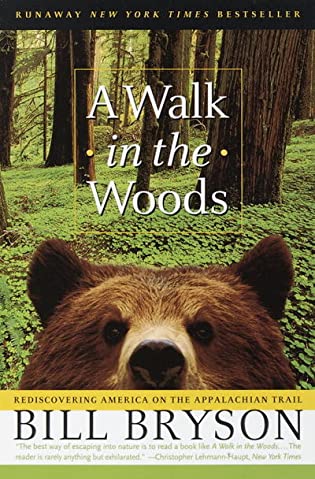 A Walk in the Woods: Rediscovering America on the Appalachian Trail by Bill Bryson
A Walk in the Woods: Rediscovering America on the Appalachian Trail by Bill Bryson Narrator: Rob McQuay
Published by Broadway Books on May 4, 1999
Genres: Memoir, Nonfiction, Travel
Length: 9 hours 47 minutes
Format: Audio, Audiobook
Source: Library
Buy on Amazon
Goodreads

Back in America after twenty years in Britain, Bill Bryson decided to reacquaint himself with his native country by walking the 2,100-mile Appalachian Trail, which stretches from Georgia to Maine. The AT offers an astonishing landscape of silent forests and sparkling lakes—and to a writer with the comic genius of Bill Bryson, it also provides endless opportunities to witness the majestic silliness of his fellow human beings. For a start, there's the gloriously out-of-shape Stephen Katz, a buddy from Iowa along for the walk. Despite Katz's overwhelming desire to find cozy restaurants, he and Bryson eventually settle into their stride, and while on the trail they meet a bizarre assortment of hilarious characters. But A Walk in the Woods is more than just a laugh-out-loud hike. Bryson's acute eye is a wise witness to this beautiful but fragile trail, and as he tells its fascinating history, he makes a moving plea for the conservation of America's last great wilderness. An adventure, a comedy, and a celebration, A Walk in the Woods has become a modern classic of travel literature.
After finishing and enjoying Bill Bryson’s book about traveling Australia, In a Sunburned Country, I wanted to read A Walk in the Woods. I have taken up walking myself, and while I harbor no desire to walk the Appalachian Trail, I understand the joy a good walk can bring. This book really brings together a few different elements. On one level, it’s the history and ecology of the AT. It’s also a travelogue, which I expected after reading In a Sunburned Country. However, what I didn’t expect (not having read reviews) was that this would be a buddy story. Bryson is accompanied on his journey—his old friend Stephen Katz joins Bryson’s hike and threatens to walk away with the whole narrative. I’d love to know Katz’s reasons for wanting to walk the AT with Bill Bryson, but I’m glad he went.
My largest problem with the book was the narrator wasn’t Bryson. He also mispronounced a few proper nouns, which always bothers me. There are more than a few Deliverance references meant to be jokes, as well. That old stereotype wears very thin after a while, but I felt Bryson was attempting to rationalize some of his anxiety; I’m not sure to what extent he really believes those stereotypes.
This book was particularly fun to listen to as I walked, and I especially enjoyed hearing about some of the places I was more familiar with—the segment on Mount Greylock was interesting to me, as I have visited it and remember seeing everything he described. I imagine it would be fun to read this book while hiking the AT. I learned a great deal about the AT, and I also learned more about ecological concerns facing conservationists today.